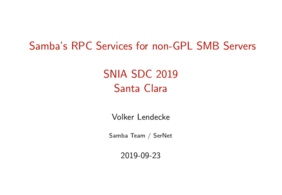At the Storage Developer Conferenece (SDC) last year (September 23 - 26, 2019, Santa Clara/California), Volker Lendecke and Ralph Böhme, both part of SerNet and the international Samba Team, gave presentations. These are available on the SNIA YouTube channel.
Ralph Böhme: What's new in Samba?
Direct Link: https://www.youtube.com/watch?v=g7cngkehwP8
Abstract: Presenting an overview on the latest advancements, new features and changes in Samba. The key focus is on Samba's SMB3 fileserver implementation, while also covering recent enhancements in Clustered Samba and Samba's implementation of Active Directory.
Volker Lendecke: Samba's RPC Services for non GPL SMB Servers
Direct Link: https://www.youtube.com/watch?v=0ePEfzPrqDg
Abstract: Implementing [MS-SMB2] is a first step towards Windows interoperability. The simple task of listing shares is a nontrivial challenge, because Windows uses the srvsvc RPC service for this. Samba provides a seamless Windows user experience, it implements both SMB and RPC. It does so in a way that can be easily split apart in a GPL-compatible manner without putting GPL requirements on the SMB implementation. This talk presents a project where a non-GPL SMB implementor uses Samba's RPC implementation to provide a share listing and other RPC-based services, providing a much shorter time to market than by implementing the RPC stack independently. The talk also covers ways forward how Samba could implement a full RPC stack usable for simple integration of other RPC-based services.
Volker Lendecke: Progress in making clustered Samba more scalable
Direct Link: https://www.youtube.com/watch?v=jewaMvKD32o
Abstract: This talk is a sequel to the 2018 talk about how to make Samba really fly in a clustered environment (direct link). It provides insights on the progress of the deep restructuring of Samba's core data structures as well as plans to optimize both the isolated as well as the heavily concurrent, shared file access that suffers from significant lock contention on internal data structures.


